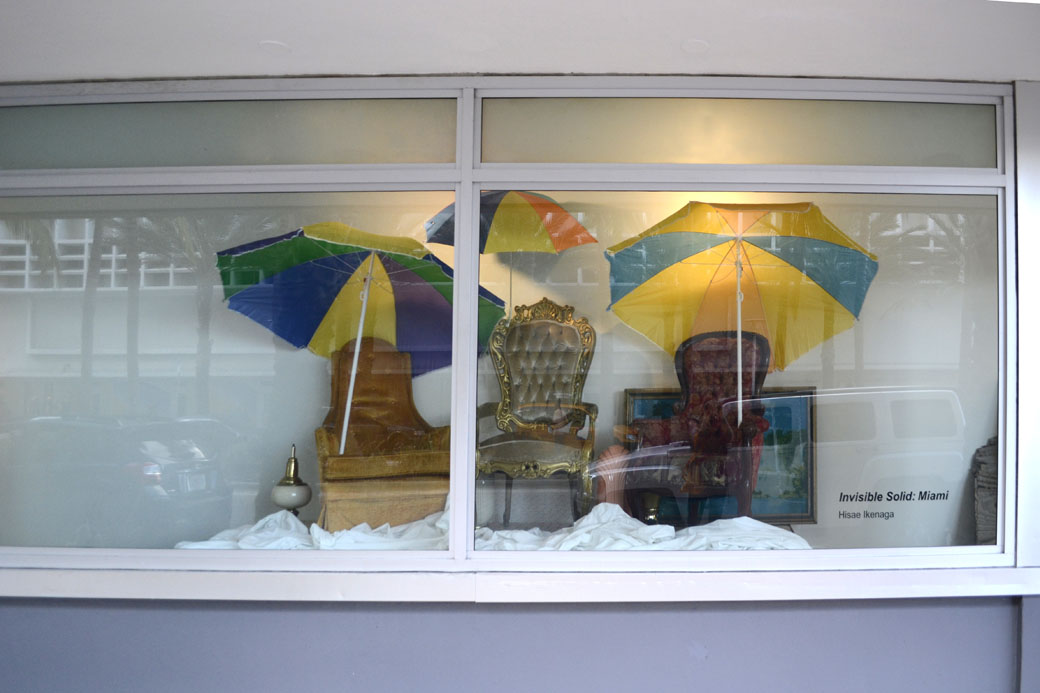
A new residency program for ArtCenter/South Florida
ArtCenter/South Florida resident Hisae Ikenaga displays her work in the window of the Lincoln Road Walgreens
By Juan Carlos Pérez-Duthie
Seems hard to believe nowadays, what with all the artistic and cultural growth in South Florida, but at one point, a three-building contemporary art exhibition space and residency haven located in Lincoln Road was the place for new artists, development, and exhibitions.
ArtCenter/South Florida contributed to making Lincoln Road, and by extension South Beach, the pedestrian attraction it is today, which in turn, presents new challenges to the 30-year-old institution. Tackling those challenges is María del Valle, who became the executive director in 2012.
In 2013, the ArtCenter received a Knight Arts Challenge award for its new residency program. The two-fold purpose: to bring mid-career creative talents from other cities and invite established Miami artists who work in international markets to come back and devote themselves to special projects for specific amounts of time. (Emerging artists, don’t despair: in the works are more fellowships for you as well, Del Valle said).
Wasting no time, the 49-year-old director used her contacts in the art world and in Spain to bring the exhibit One Out of One Thousand here, in partnership with Acción Cultural Española. As the Knight Arts Challenge once again seeks applications from South Florida, Del Valle chatted with Knight Foundation about the new residency program as a work in progress, and much more.
It is probably more competitive than ever for artists and non-profit arts institutions like ArtCenter to get grants. You managed to win an award that lasts through 2016. How did this initiative come about?
MDV: The residency model followed by the ArtCenter when I got there was not following the current trend in the world of residencies, in which the way to help the artist directly is to offer him or her time and space in which to create [with a small stipend and lodging]. The only model we had here was to partly finance studios for artists so that they could have an affordable space to work in. We wanted to complement this a bit. Miami has increasingly become a vital center in the visual arts. A lot of people want to come here, they want to see what is happening here, and we were lacking a competent program to bring artists from outside of Miami. And since we already cover Miami-based artists with our original residency program, we felt it was the perfect way to add to it: having short residences, one month to three months tops, with artists who are not from Miami, or artists who had been here years ago.
In spite of the drastic transformation that South Beach has experienced over the last 25 years, the ArtCenter has been a constant. Does the new residency program fit into some kind of new philosophy or vision for the ArtCenter?
MDV: The location has a bit of everything: things that are good, and things that are difficult. Our location receives a lot of foot traffic, so we want to strengthen this. We have a place with a large audience of spectators who just happen to walk by. This is a spectator that usually does not go directly to the ArtCenter, but just finds it. We are trying to make our contribution to these people who might have no other contact with contemporary art. A great number of them come with their towels and flip flops, and they are really not expecting to find any contemporary art offerings. So we want the artists to go beyond their comfort zone and think of this type of visitor who perhaps does not go to museums and is also not expecting a cultural experience. This makes for a very interesting dialogue. How do I hook this accidental visitor who comes into the space? If we can make these visitors want to know more about contemporary art, we will have fulfilled one of our goals. Our second goal is to have Miami’s cultural crowd come here, which is not an easy task due to parking problems, or because we are not that visible. For the future, and as part of the vision of the ArtCenter, we are working on different scenarios. The world changes, everything evolves, so we can’t guarantee what the ArtCenter’s future will be. What is clear is that because of this unique location, we are going to have a strong presence on Lincoln Road.
I suppose there are great economic pressures hitting you from all sides.
MDV: The ArtCenter’s founders had an outstanding vision, because they bought these buildings. But the environment has changed tremendously. We are surrounded by franchises; even the Van Dyke [Café] has disappeared! That’s why we believe that the ideal scenario for us, and we are fighting for it, is to have the best of both worlds: to keep a strong presence here, because we think we can make a difference and offer things that are really unique, and at the same time, don’t rule out sensibly increasing our economic resources in order to present other activities in Miami as well. We think that the presence of public programs and exhibits is worth keeping in Miami Beach.
ArtCenter/South Florida studios: 800 / 810 / 924 Lincoln Rd. Richard Shack Gallery: 800 Lincoln Road. Office: 924 Lincoln Road, Suite 205, Miami Beach. Juan Carlos Pérez-Duthie is a Miami-based freelance writer
Recent Content
-
Artsarticle ·
-
Artsarticle ·
-
Artsarticle ·
